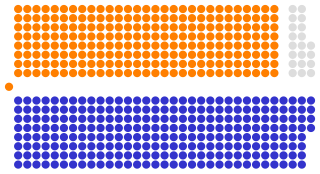
The Acts of Union refer to two Acts of Parliament, one by the Parliament of England in 1706, the other by the Parliament of Scotland in 1707. They put into effect the Treaty of Union agreed on 22 July 1706, which merged the previously separate Kingdom of England and Kingdom of Scotland into a single Kingdom of Great Britain, with Queen Anne as its sovereign. The Acts took effect on 1 May 1707, creating the Parliament of Great Britain, based in the Palace of Westminster.

James Ogilvy, 4th Earl of Findlater and 1st Earl of Seafield, was a Scottish politician, prominent during the reign of Queen Anne. He was created Earl of Seafield in 1701 and was an active supporter of the 1707 Act of Union although by 1714 his opinion of the Union had changed and he proposed the first Self Government for Scotland Bill to end the Union.

James Douglas, 2nd Duke of Queensberry and 1st Duke of Dover was a Scottish nobleman and a leading politician of the late 17th and the early 18th centuries. As Lord High Commissioner he was instrumental in negotiating and passing the Acts of Union 1707 with England, which created the Kingdom of Great Britain.

The Treaty of Union is the name usually now given to the treaty which led to the creation of the new state of Great Britain. The treaty united the Kingdom of England and the Kingdom of Scotland to be "United into One Kingdom by the Name of Great Britain". At the time it was more often referred to as the Articles of Union.
The Scottish representatives to the first Parliament of Great Britain, serving from 1 May 1707 to 26 May 1708, were not elected like their colleagues from England and Wales, but rather hand-picked.

The first Parliament of the Kingdom of Great Britain was established in 1707 after the merger of the Kingdom of England and the Kingdom of Scotland. It was in fact the 4th and last session of the 2nd Parliament of Queen Anne suitably renamed: no fresh elections were held in England or in Wales, and the existing members of the House of Commons of England sat as members of the new House of Commons of Great Britain. In Scotland, prior to the union coming into effect, the Scottish Parliament appointed sixteen peers and 45 Members of Parliaments to join their English counterparts at Westminster.

John Smith (1656–1723) of Tedworth House, Hampshire, was an English politician who sat in the English and British House of Commons between 1678 and 1723. He served as Speaker and twice as Chancellor of the Exchequer.
This is a list of the parliaments of the United Kingdom, of Great Britain and of England from 1660 to the present day, with the duration of each parliament. The NP number is the number counting forward from the creation of the United Kingdom in 1801 and Great Britain in 1707. Prior to that, the parliaments are counted from the Restoration in 1660.

Lionel Tollemache, 3rd Earl of Dysart, styled Lord Huntingtower from 1651 to 1698, was a British Tory politician and peer. A Member of Parliament at Westminster, he inherited Scottish peerages and was briefly Lord Lieutenant of Suffolk from 1703 to 1705.
The Right Honourable Frederick Hamilton was an Irish politician who represented County Donegal in three Irish parliaments. He was also heir apparent to his father, Gustavus Hamilton, 1st Viscount Boyne. He predeceased him but his son succeeded as the 3rd viscount.

Henry Graham, of Levens, also spelt Grahme, was an English gentleman, heir to a Westmorland estate, and member of parliament.

The 1705 English general election saw contests in 110 constituencies in England and Wales, roughly 41% of the total. The election was fiercely fought, with mob violence and cries of "Church in Danger" occurring in several boroughs. During the previous session of Parliament the Tories had become increasingly unpopular, and their position was therefore somewhat weakened by the election, particularly by the Tackers controversy. Due to the uncertain loyalty of a group of 'moderate' Tories led by Robert Harley, the parties were roughly balanced in the House of Commons following the election, encouraging the Whigs to demand a greater share in the government led by Marlborough

The 1st Parliament of Queen Anne was summoned by Queen Anne of England on 2 July 1702 and assembled on 20 August 1702. Its composition was 298 Tories, 184 Whigs and 31 others, representing a large swing to the Tories since the previous election. Robert Harley, the member for Radnor, was re-elected Speaker of the House of Commons.
Hugh Campbell, 3rd Earl of Loudoun, KT, PC was a Scottish landowner, peer, and statesman.











